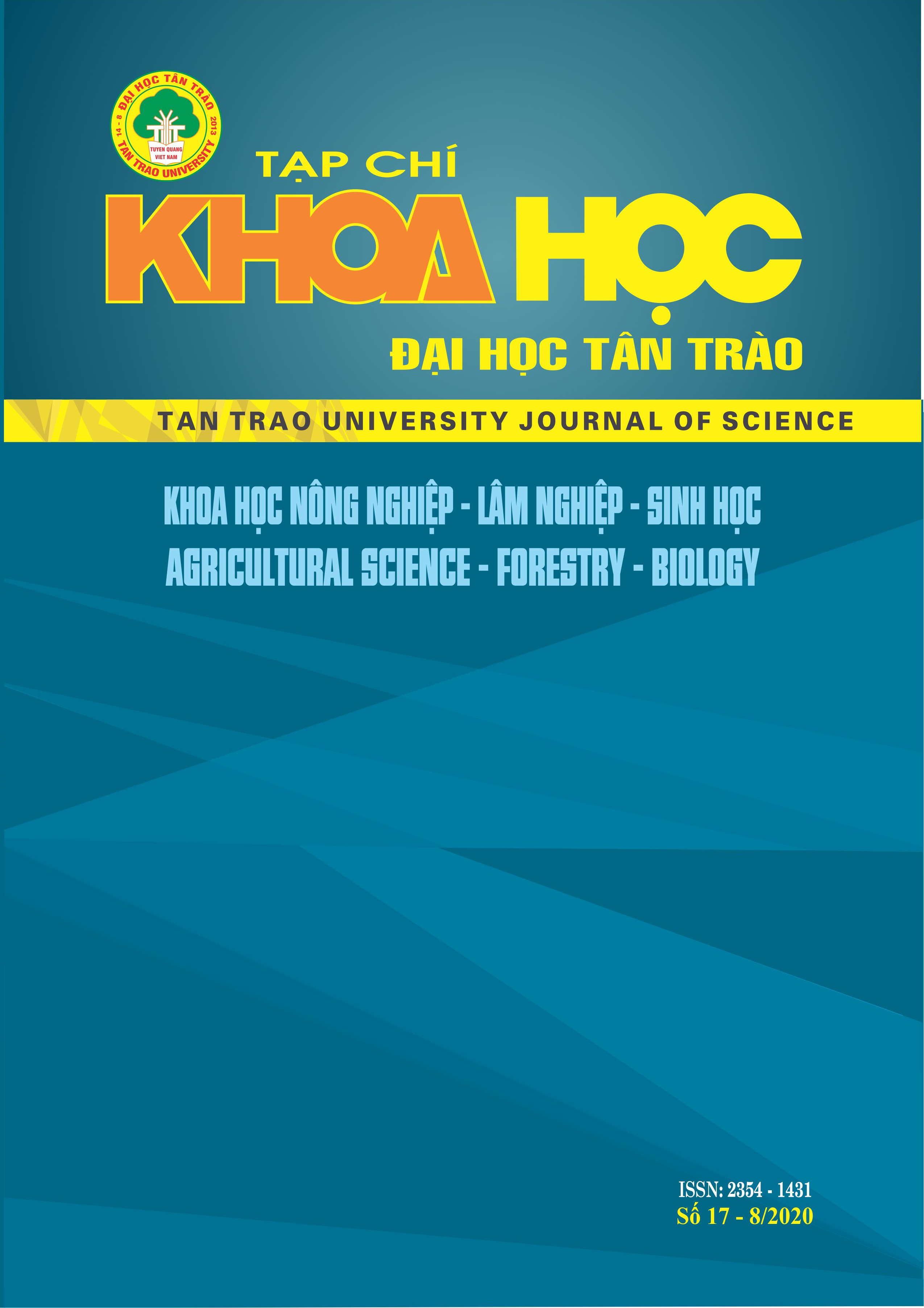NGHIÊN CỨU TỶ LỆ PHỐI TRỘN THÍCH HỢP GIỮA CHITOSAN VÀ NISIN ĐỂ BẢO QUẢN CAM SAU THU HOẠCH Ở NHIỆT ĐỘ THƯỜNG
DOI:
https://doi.org/10.51453/2354-1431/2020/387Từ khóa:
Chitosan; nisin; phối trá»™n; quả cam; sau thu hoạch.Tóm tắt
Nghiên cứu này tập trung vào việc trộn chitosan và nisin theo các tỷ lệ khác nhau, nhằm mang lại kết quả tốt nhất cho việc bảo quản cam ở nhiệt độ phòng. Thực nghiệm cho thấy tỷ lệ phối trộn giữa chitosan và nisin lần lượt là 1,5% và 400 IU / ml bảo quản cam ở nhiệt độ phòng cho kết quả tốt nhất sau 8 tuần bảo quản, cụ thể: tỷ lệ hư hỏng là 26,67%, tỷ lệ hao hụt khối lượng là 29,04%. , tổng hàm lượng axit hữu cơ là 0,56% tổng chất khô, hàm lượng vitamin C còn lại là 29,43 mg / 100g tổng chất khô, hàm lượng chất khô hòa tan là 10,3oBx
Tải xuống
Tài liệu tham khảo
1. Nguyen Huu Dang, Citrus fruits, Publisher: Agriculture, 2003.
2. Quach Dinh, Nguyen Van Tiep, Nguyen Van Thao, Technology after harvesting and processing vegetables. Publisher:Science and Technology , 1996.
3. Huynh Nguyen Duy Bao, Tran Thi Luyen et al., Completing Chitin - Chitosan production process and processing some industrial products from shrimp and crab shell scrap. Scientific report (ministry level) Nha Trang, 2000.
4. Luu Van Chinh, Chau Van Minh, Pham Huu Dien, Vu Manh Hung, Ngo Thi Thuan, "Synthesize and research the blood cholesterol lowering effect of N, N, N - trimethy chitosan", Journal of Pharmacology, (No. 9), sec. 5, 2000.
5. Tran Thi Luyen, Le Thanh Long, "Research on preserving fresh chicken eggs with chitosan coated with additives", Journal of Fisheries Science and Technology, Nha Trang University, No. 1, p. 3 -11, 2007.
6. Do Thi Huyen, et al., "Research on production technology and use of biocides (nisin and enterocin) used in preserving agricultural products and foodstuffs". Synthesized report on scientific and technological results of scientific and technological topics at the state level, 2010.
7. Kykkidou S, Pournis N, Kostoula OK, Savvaidis IN, "Effects of treatment with nisin on the microbial flora and sensory properties of a Greek soft acid - curd cheese stored aerobically at 4°C", Int Dairy J, 17(10):1254 -1258, 2007
8. Nguyen La Anh. Research on technology to produce bacterioxin bio-preservative by microbiological method, which is applied in the food industry. Synthesized report on scientific and technological results on the topic of international cooperation tasks on science and technology according to protocol, 2010.
9. Tran Thi Hien. Application of chitosan-nano silver combination product in orange preservation. Graduate thesis. Agriculture and Forestry University - Thai Nguyen University, 2015.
10. Tran Thi Hai. Application of chitosan-nano silver combination in pomelos preservation. Graduate thesis. Agriculture and Forestry University - Thai Nguyen University, 2015.
11. Nguyen Duc Tuan, Ha Quang Viet, Ta Thi Mua. "Research on the effect of concentration of chitosan on quality and preservation time of Doan Hung grapefruit (Citrus grandis Osbeck)". Journal of Agriculture and Rural Development, November 2010, p. 80-83.
12. Ha Van Thuyet, Tran Quang Binh (2002), Preserving fresh fruits and vegetables and selling inoculants, Agricultural Publisher, 2002.
13. Delves-Broughton, J (1990), Nisin and it’s uses as a food preservation, Food Technology, 100-117.
14. Le Thanh Mai (2006),The analytical method of fermentation industry. Publisher: Science and Technology
Tải xuống
Đã Xuất bản
Cách trích dẫn
Số
Chuyên mục
Giấy phép

Tác phẩm này được cấp phép theo Giấy phép Quốc tế Creative Commons Attribution-ShareAlike 4.0 .
Bài báo được xuất bản ở Tạp chí Khoa học Đại học Tân Trào được cấp phép theo giấy phép Ghi công - Chia sẻ tương tự 4.0 Quốc tế (CC BY-SA). Theo đó, các tác giả khác có thể sao chép, chuyển đổi hay phân phối lại các bài báo này với mục đích hợp pháp trên mọi phương tiện, với điều kiện họ trích dẫn tác giả, Tạp chí Khoa học Đại học Tân Trào và đường link đến bản quyền; nêu rõ các thay đổi đã thực hiện và các nghiên cứu đăng lại được tiến hành theo cùng một bản quyền.
Bản quyền bài báo thuộc về các tác giả, không hạn chế số lượng. Tạp chí Khoa học Tân Trào được cấp giấy phép không độc quyền để xuất bản bài báo với tư cách nhà xuất bản nguồn, kèm theo quyền thương mại để in các bài báo cung cấp cho các thư viện và cá nhân.
Mặc dù các điều khoản của giấy phép CC BY-SA không dành cho các tác giả (với tư cách là người giữ bản quyền của bài báo, họ không bị hạn chế về quyền hạn), khi gửi bài tới Tạp chí Khoa học Đại học Tân Trào, tác giả cần đáp ứng quyền của độc giả, và cần cấp quyền cho bên thứ 3 sử dụng bài báo của họ trong phạm vi của giấy phép.






